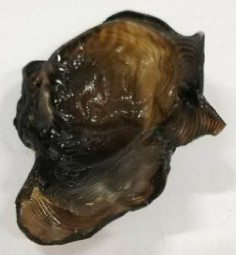Recovery method of retired lithium ion battery positive electrode binder
A lithium-ion battery and recovery method technology, which is applied in the field of recovery and regeneration of key materials of lithium-ion batteries, can solve problems such as poor dissolution effect, low recovery efficiency of adhesives, and large consumption of ethanol washing, achieving high recovery efficiency and low investment , to achieve the effect of reasonable utilization
- Summary
- Abstract
- Description
- Claims
- Application Information
AI Technical Summary
Problems solved by technology
Method used
Image
Examples
Embodiment 1
[0024] The mixed solvent of DMF and acetonitrile and the positive electrode powder are weighed according to the mass ratio of 10:1, and the positive electrode powder is poured into the organic mixed solvent, and ultrasonically, so that the positive electrode powder is completely immersed in the organic mixed solvent to prepare a suspension. Place the suspension in the reaction kettle, keep the pressure of the reaction kettle at -0.1MPa, and use mechanical stirring to stir the suspension at the same time, the stirring rate is 400r / min, the time is 5h, and the heating temperature is 60 °C, so that the adhesive Fully dissolved. Then, add DMF to the reactor at a volume ratio of 5:1, dilute it and place it in a centrifuge, the centrifugation rate is 12000rmp / min, the centrifugation time is 5min / time, and the number of centrifugation is 7 times to separate Cathode powder and organic solution containing PVDF. Put the organic solution containing PVDF into the vacuum rotary evaporator...
Embodiment 2
[0026] The mixed solvent of DMF and acetonitrile and the positive electrode powder were weighed according to the mass ratio of 30:1, and the positive electrode powder was poured into the organic mixed solvent, and ultrasonically, so that the positive electrode powder was completely immersed in the organic mixed solvent to prepare a suspension. Place the suspension in the reaction kettle, keep the pressure of the reaction kettle at -0.1MPa, and use mechanical stirring to stir the suspension at the same time. The agent is fully dissolved. Then, add DMF to the reaction kettle according to the volume ratio of 2:1, dilute it and place it in a centrifuge. Cathode powder and organic solution containing PVDF. Put the organic solution containing PVDF into the vacuum rotary evaporator, keep the vacuum degree at 500pa and the heating temperature at 40℃, and separate the organic mixed solvent and PVDF.
Embodiment 3
[0028] The mixed solvent of NMP and acetonitrile and the positive electrode powder were weighed according to the mass ratio of 2:1, and the positive electrode powder was poured into the organic mixed solvent, and ultrasonically, so that the positive electrode powder was completely immersed in the organic mixed solvent to prepare a suspension. Place the suspension in the reaction kettle, keep the pressure of the reaction kettle at -0.1MPa, and use mechanical stirring to stir the suspension at the same time. Fully dissolved. Then, add DMF to the reactor at a volume ratio of 10:1, dilute it and place it in a centrifuge. Cathode powder and organic solution containing PVDF. Put the organic solution containing PVDF into the vacuum rotary evaporator, keep the vacuum degree at 500pa and the heating temperature at 60℃, and separate the organic mixed solvent and PVDF.
PUM
 Login to View More
Login to View More Abstract
Description
Claims
Application Information
 Login to View More
Login to View More - R&D
- Intellectual Property
- Life Sciences
- Materials
- Tech Scout
- Unparalleled Data Quality
- Higher Quality Content
- 60% Fewer Hallucinations
Browse by: Latest US Patents, China's latest patents, Technical Efficacy Thesaurus, Application Domain, Technology Topic, Popular Technical Reports.
© 2025 PatSnap. All rights reserved.Legal|Privacy policy|Modern Slavery Act Transparency Statement|Sitemap|About US| Contact US: help@patsnap.com

